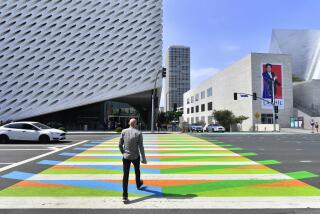Op-Ed: Despite the Ghost Ship fire, L.A. artists need warehouses in the housing mix

Converted industrial spaces like Oakland’s Ghost Ship warehouse have for decades sheltered some of the country’s brightest artist-innovators—the people who usher in the New Wave, and the wave after that. As the underground art community mourns the 36 young people killed in the Ghost Ship fire, we’re also worried that municipalities will use the tragedy as an excuse to crack down on similar spaces of questionable legality. Already in Los Angeles, officials are planning a meeting to address the city’s unpermitted dwellings.
The descriptions of the Ghost Ship warehouse found everywhere in the news media are, in the context of a lethal fire, simply horrifying. A “dilapidated” place, we’re told, a “cluttered labyrinth” or “tinderbox.” With the exception of that last term, however, these could easily be selling points on an event flier. Dilapidation is what many people in L.A.’s urban art scene desperately crave. A “labyrinth” is a compelling alternative to an unimaginative, empty box of a nightclub where yuppies buy pricey cocktails and the lights come on for last call at 1:30 a.m.
It hasn’t escaped anyone’s attention that downtown L.A. is booming after a long, dangerous fallow period. That’s not a result of real estate developers — though of course they’re profiting from it — but of artists flocking to the neighborhood from around the world, Brooklyn to Berlin. Nor has it escaped anyone’s attention that downtown L.A. is getting very, very expensive. According to Curbed, the average rent for a one-bedroom apartment in downtown L.A. as of last year was $2,380. If what you do for a living is make cutting-edge electronic music, you simply can’t afford that.
So where do artists live? The artists who revitalized downtown? Often in situations not entirely unlike Ghost Ship — illegal and ill- or unmaintained buildings meant for non-residential uses. They have no other choice. And right next to the artists you’ll find at-risk young people who, for various reasons, had to leave home. Los Angeles reportedly has the highest number of LGBT homeless youth in the United States; living in a warehouse is definitely a step up from the streets.
If well-meaning officials take an “aggressive” approach to illegal dwellings, as the news media have reported, where will all these people go?
Of course safety matters, but a rapid regulatory crackdown will almost certainly lead to evictions, which will, in turn, contribute to the city’s homelessness problem. There has to be another solution; some way to encourage landlords to make safety improvements without removing converted spaces from the housing mix altogether. If the city wants to make sure landlords install working smoke alarms and fire escapes, fine. But not everyone needs, or wants, to live in a traditional apartment, especially when it comes to creatives attracted to Los Angeles.
In the big picture, who’s to blame here? Artists going to parties? Less-than-scrupulous landlords who ignore faulty electronics? Or is it soaring prices and all those new “luxury” developments — the ones replacing more modest options? Efforts made in the name of preventing future catastrophes may, unintentionally, make housing even less affordable, and force artists even further underground — or out of their very own “Arts District” altogether.
Austin Allyn is an international organizer of warehouse events, performance art happenings and charity fundraisers based in downtown Los Angeles.
Follow the Opinion section on Twitter @latimesopinion or Facebook
More to Read
A cure for the common opinion
Get thought-provoking perspectives with our weekly newsletter.
You may occasionally receive promotional content from the Los Angeles Times.






